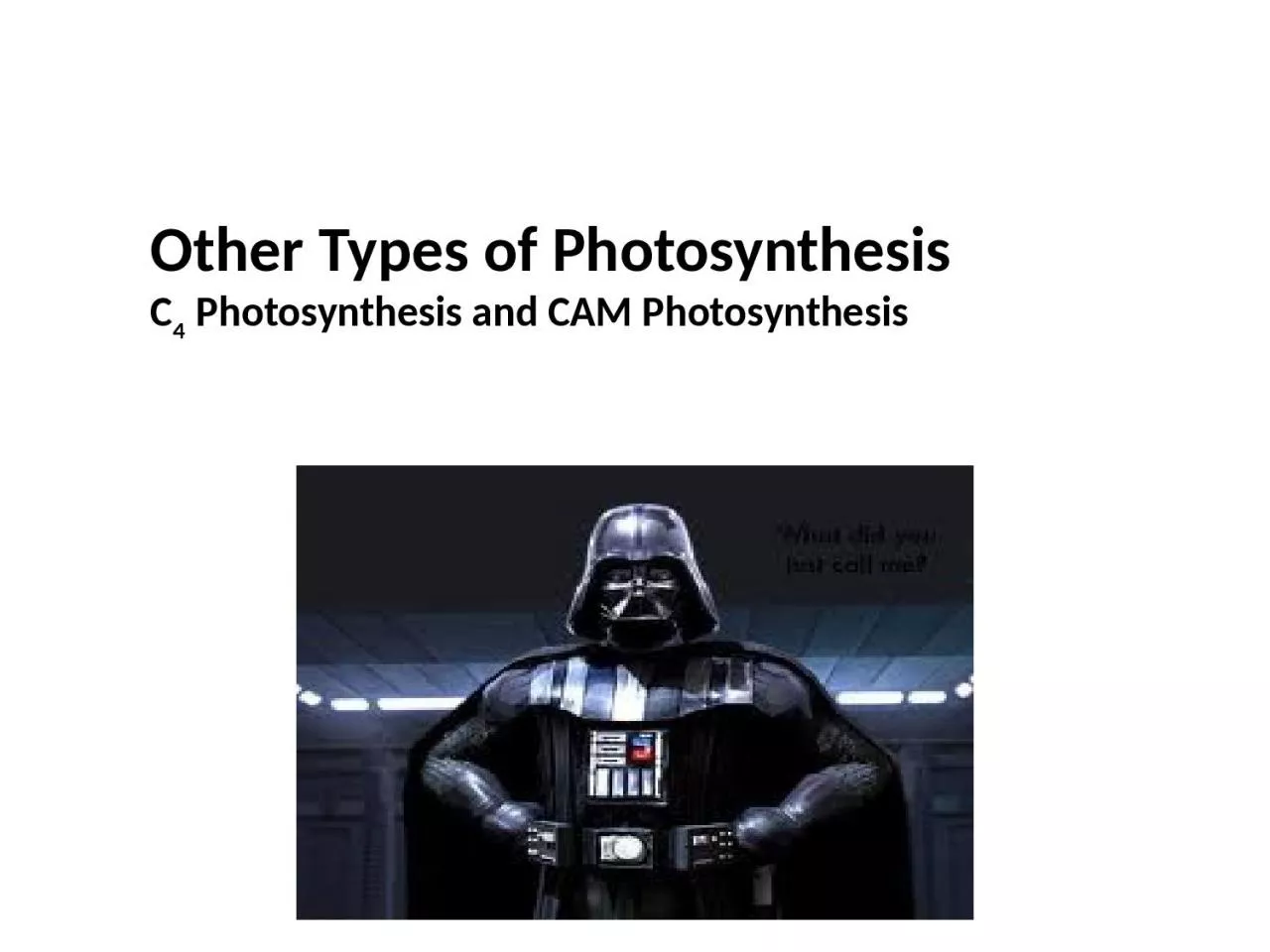

C 4 Photosynthesis and CAM Photosynthesis 2 3 Calvin Cycle Reactions Carbon Dioxide Fixation CO 2 is attached to 5carbon RuBP molecule Result in a 6carbon molecule This splits into two 3carbon molecules 3PG ID: 1026630
Download Presentation The PPT/PDF document "Other Types of Photosynthesis" is the property of its rightful owner. Permission is granted to download and print the materials on this web site for personal, non-commercial use only, and to display it on your personal computer provided you do not modify the materials and that you retain all copyright notices contained in the materials. By downloading content from our website, you accept the terms of this agreement.
1. Other Types of PhotosynthesisC4 Photosynthesis and CAM Photosynthesis
2. 2
3. 3Calvin Cycle Reactions:Carbon Dioxide FixationCO2 is attached to 5-carbon RuBP moleculeResult in a 6-carbon moleculeThis splits into two 3-carbon molecules (3PG)Reaction accelerated by RuBP Carboxylase (Rubisco)CO2 now “fixed” because it is part of a carbohydrate
4. 4Calvin Cycle Reactions:Carbon Dioxide Reduction3PG reduced to BPGBPG then reduced to G3PUtilizes NADPH and some ATP produced in light reactions
5. 5Calvin Cycle Reactions:Regeneration of RuBPRuBP used in CO2 fixation must be replacedEvery three turns of Calvin Cycle,Five G3P (a 3-carbon molecule) used To remake three RuBP (a 5-carbon molecule)
6. 6The Calvin Cycle: Fixation of CO2
7. 7Importance of Calvin CycleG3P (glyceraldehyde-3-phosphate) can be converted to many other moleculesThe hydrocarbon skeleton of G3P can formFatty acids and glycerol to make plant oilsGlucose phosphate (simple sugar)Fructose (which with glucose = sucrose)Starch and celluloseAmino acids
8.
9. Other Types of PhotosynthesisC4 Photosynthesis and CAM Photosynthesis
10. In C3 plants, the Calvin cycle fixes CO2 directly; the first molecule following CO2 fixation is 3PG.In hot weather, stomata close to save water; CO2 concentration decreases in leaves; O2 increases.O2 combines with RuBP instead of CO2 This is called photorespiration since oxygen is taken up and CO2 is produced; this produces less 3PG.Most plants are C3 plants
11. In a C3 plant, mesophyll cells contain well‑formed chloroplasts, arranged in parallel layers.In C4 plants, bundle sheath cells as well as the mesophyll cells contain chloroplasts.In C4 leaf, mesophyll cells are arranged concentrically around the bundle sheath cells.C4 Photosynthesis
12. Remember C3 plants use RuBP carboxylase to fix CO2 to RuBP in mesophyll; the first detected molecule is 3PG.C4 plants use the enzyme PEP carboxylase (PEPCase) to fix CO2 to PEP (phosphoenolpyruvate, a C3 molecule); the end product is oxaloacetate (a C4 molecule).In C4 plants, CO2 is taken up in mesophyll cells and malate, a reduced form of oxaloacetate, is pumped into the bundle‑sheath cells; here CO2 enters Calvin cycle.In hot, dry climates, net photosynthetic rate of C4 plants (e.g., corn) is 2–3 times that of C3 plants.Photorespiration does not occur in C4 leaves because PEP does not combine with O2; even when stomata are closed, CO2 is delivered to the Calvin cycle in bundle sheath cells.C4 plants have advantage over C3 plants in hot and dry weather because photorespiration does not occur; e.g., bluegrass (C3) dominates lawns in early summer, whereas crabgrass (C4) takes over in the hot midsummer.C4 Photosynthesis
13. CAM (crassulacean‑acid metabolism) plants form a C4 molecule at night when stomata can open without loss of water; found in many succulent desert plants including the family Crassulaceae. At night, CAM plants use PEPCase to fix CO2 by forming C4 molecule stored in large vacuoles in mesophyll.C4 formed at night is broken down to CO2 during the day and enters the Calvin cycle which now has NADPH and ATP available to it from the light‑dependent reactions.CAM plants open stomata only at night, allowing CO2 to enter photosynthesizing tissues; during the day, stomata are closed to conserve water but now CO2 cannot enter photosynthesizing tissues.Photosynthesis in a CAM plant is minimal, due to limited amount of CO2 fixed at night; but this does allow CAM plants to live under stressful conditions.CAM Photosynthesis